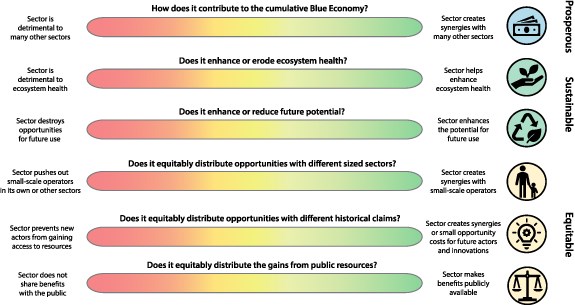News
•
15 jun 2021
Principles for a sounder Blue Economy
The rapid expansion of industrial activities in the ocean continues to outpace global regulatory efforts and to generate negative consequences for local communities, small-scale operators and the ocean ecosystem. Negative interactions between sectors like fishing, mining and shipping are adding to the problem. A new review shows that 13 out of 14 ocean sectors harm vulnerable ecosystems which also damage other sectors, and provides guidelines for a sustainably and more just use of the ocean.
The research team, led by GEDB executive director Beatrice Crona, and including colleagues from GEDB, Stockholm Resilience Centre, the Swedish Public Health Authority, the University of Tasmania, Stanford Centre for Ocean Solutions and Lancaster University, analysed 3817 articles to map interactions between economically important ocean sectors and how these interactions are mediated by changes in the natural environment.
Most of the identified interactions have negative, or antagonistic, effects on other sectors, with diminished touristic value and degradation of the natural capital on which another sector depends being the most widely experienced impacts. Interactions with positive outcomes for other sectors are much less frequent.
“Our work shows that most ocean sectors negatively impact the biosphere base on which they jointly rely - and thus negatively affect each other. This risks promoting an overoptimistic idea of what Blue Economy growth can deliver”, says Beatrice Crona.
Fishing stands out as the most highly connected industry, but tourism, drilling, and shipping also interact with many other sectors, directly or via mediating activities. These patterns may in part reflect historical development of industries. The ocean ecosystem plays a key role in mediating many ocean sector interactions.
The authors also find three key features that cut across all ocean sector interactions: (a) the cumulative nature of many sector impacts on ecosystems; (b) observed time-lags in how impacts are manifested; and (c) the power inequality of ocean sectors and other relevant and affected actors to exert their rights or demands in the development of the ocean.
Based on their analysis the authors conclude by proposing a set of principles that can begin to guide decision-making prioritizations, by flagging likely trade-offs and identifying opportunities for sustainable and equitable governance.

Figure: Guiding principles for delivering a prosperous, sustainable and equitable Blue Economy. The principles are operationalized through questions which put focus on six key economic, environmental and social dimensions brought to the fore by our analysis of ocean sector interactions. These should be seen as a deliberation tool to compare and contrast sectors and actors in the ocean domain, helping to highlight potentially costly trade-offs, or indicate opportunities for synergies in any decision situation.
Alongside these principles the team have developed an interactive tool for readers and decision-makers to explore ocean sector interactions
Crona, B., E. Wassénius, K. Lillepold, R. Watson, E. Selig, C. Hicks, H. Österblom, C. Folke, J.B. Jouffray and R. Blasiak. 2021. Sharing the seas: A review and analysis of ocean sector interactions. Environmental Research Letters 16 063005.
